Authentic replicas of Roman fibulae, medieval clasps and Viking brooches
Here you can buy a large section of Roman fibulas or medieval and Viking brooches.Continue ...
Retailers for LARP or medieval re-enactment are welcome to register for our medieval wholesale store.
Categories
-
Celtic Brooches
 Buy Celtic Jewellery - Replicas of Celtic brooches and fibulae from the Latène Era
Buy Celtic Jewellery - Replicas of Celtic brooches and fibulae from the Latène Era -
Roman Brooches
 Hery you can buy Roman brooches and historical fibula replicas of the Antiquity
Hery you can buy Roman brooches and historical fibula replicas of the Antiquity -
Viking Brooches
 Viking jewellery - Here you can buy Viking brooches and authentic fibula replicas.
Viking jewellery - Here you can buy Viking brooches and authentic fibula replicas. -
Early Medieval Brooches
 Buy authentic replicas of brooches and fibulas after finds of the early Middle Ages.
Buy authentic replicas of brooches and fibulas after finds of the early Middle Ages. -
Medieval Brooches
 Medieval jewellery replicas. Buy authentic ring brooches of the Middle Ages.
Medieval jewellery replicas. Buy authentic ring brooches of the Middle Ages. -
Forged Brooches
 Forged Brooches. Buy iron fibulas for LARP, Medieval and Viking Re-enactment
Forged Brooches. Buy iron fibulas for LARP, Medieval and Viking Re-enactment -
Dress Fasteners
 Dress fasteners and garment hooks for LARP and medieval re-enactment
Dress fasteners and garment hooks for LARP and medieval re-enactment
Dealers for museum supplies, medieval and Viking re-enactment or LARP are cordially invited to register as retailer for wholesale in Pera Peri's medieval shop. We guarantee the best quality at good prices with short delivery times!
Popular Products
-
 Viking Bead Separator from Öland10,08 €*Quick Order
Viking Bead Separator from Öland10,08 €*Quick Order -
 Forged Viking leg wrap brooch3,35 €*Quick Order
Forged Viking leg wrap brooch3,35 €*Quick Order -
 Small jewellery hook0,83 €*Quick Order
Small jewellery hook0,83 €*Quick Order -
 Wolf Head Hook Fastener6,71 €*Quick Order
Wolf Head Hook Fastener6,71 €*Quick Order -
 Small Oval Brooch21,84 €*Quick Order
Small Oval Brooch21,84 €*Quick Order -
 Urnes Style Dress Fastener11,76 €*Quick Order
Urnes Style Dress Fastener11,76 €*Quick Order -
 Raven Brooch of the Vendel era11,76 €*Quick Order
Raven Brooch of the Vendel era11,76 €*Quick Order
New Articles
show 1 to 28 (out of a total of 270 articles)
Garment clasps from antiquity to the Middle Ages
 Buy vestment clasps, brooches and clasps at Pera Peris.
Buy vestment clasps, brooches and clasps at Pera Peris.
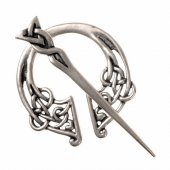 If you are looking for an authentic replica of a historical garment clasp for an authentic presentation, then you have found the right place.
If you are looking for an authentic replica of a historical garment clasp for an authentic presentation, then you have found the right place.At Pera Peris - Haus of history you can buy replicas of brooches and garment clasps, which were manufactured in detail after historical models from antiquity, Viking Era and the Middle Ages.
In the category garment clasps you will find a wide selection of historical fibulas from the jewellery collection of Pera Peris. Here we offer Celtic and Roman brooches as well as authentic brooches from the Merovingian period and the Viking Age.
Our garment clasps are made of high-quality bronze and are characterized by a particularly beautiful golden yellow alloy. You can also buy our historical brooches in genuine silver-plated, whereby they are provided with an extra strong silver layer of up to 10 Mg.
In addition, many of our brooches and fibulas are provided with a special tarnish protection, which ensures that the metal does not oxidize and darken so easily or the silver does not turn black. So you will enjoy your historical garment closures for a long time.
 The fibulas of the Antiquity
The fibulas of the Antiquity
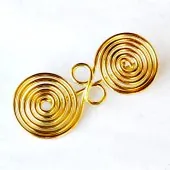 Fibulas were used for thousands of years to close the garment and were created in the course of the invention of metalworking in the early Bronze Age.
Fibulas were used for thousands of years to close the garment and were created in the course of the invention of metalworking in the early Bronze Age.Therefore, fibulas serve archaeologists as an important guide for classifying artefacts in their temporal environment, since the shape of historical garment clasps has always been very typical in the taste of their time.
The differences between the different types of fibulae result in a detailed typology of chronologically consecutive models that provide reliable assistance in the temporal assessment of accompanying finds.
Robe clasps in the form of a wide variety of fibulas dominated the garments of the most diverse peoples for about 4000 years, from the beginning of the Bronze Age and through the Celtic, Roman and Germanic Iron Age, through the horrors of the Migration Period and the Early Middle Ages, to the time of the Vikings.
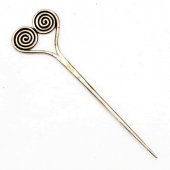 In the Middle Ages, the custom of wearing a brooch as a robe pin gradually came to an end, and was finally only found in the northeastern part of Europe, in the territories of the Vikings and Slavs.
In the Middle Ages, the custom of wearing a brooch as a robe pin gradually came to an end, and was finally only found in the northeastern part of Europe, in the territories of the Vikings and Slavs.The brooch was used in antiquity as an elementary part of clothing, especially by the Celts, Romans and Germanic tribes, but vestment clasps were also worn by other peoples such as the Greeks, Byzantines, Scythians and the eastern peoples of the steppes.
The term fibula comes from the Latin word fibula, which denotes the fibula bone, since the oldest forms of robe clasps were robe pins carved from thin bones.
Even when robe needles were made of metal, this designation remained and later it was also adopted for the fibulae that followed.
During the late 7th century BC, the fibula replaced the bronze pins that had been common until then, and a wide range of fibula forms was soon emerging, which were markedly different both locally and chronologically.
Fibulas were worn by both men and women to close the neckline of a garment or a cape, or to drape the fabric of a garment, as was necessary with the peblos, which was the customary female costume in antiquity.
In addition to their practical function, garment clasps always had a decorative character and, due to their material and design, provided information about the rank and status of the wearer within society.
For this reason, garment clasps could only be made of simple iron or bronze and sometimes even be made of silver or gold, with coral, garnet and enamel inlays.
 Early medieval brooches
Early medieval brooches
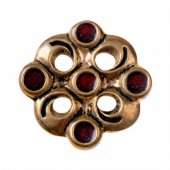 Although buttons were well known in the early Middle Ages, the people of that era preferred to use a brooch to close their clothes.
Although buttons were well known in the early Middle Ages, the people of that era preferred to use a brooch to close their clothes.While only very few garment clasps have survived from the Carolingian period, brooches were worn very often in the preceding Merovingian period in the 6th and 7th centuries, especially by the Alemannic and Franconians.
Here, especially the disc brooch and bow brooch were common as part of the Merovingian period four-fibula costume, in which two small disc brooches were worn on the chest in combination with two larger bow brooches in the hip region.
In addition to round disc brooches, other garment closures were also common in the early Middle Ages, such as the S-shaped fibula, the Franconian bird brooch and the rosette brooch, which was decorated with precious inlays of red garnet.
 The medieval disc brooches
The medieval disc brooches
 The disc brooch is also called round brooch or plate brooch because of its shape. This brooch had a needle holder and a needle catch on the back where the needle hooked in and was mostly made of a copper alloy like bronze or silver.
The disc brooch is also called round brooch or plate brooch because of its shape. This brooch had a needle holder and a needle catch on the back where the needle hooked in and was mostly made of a copper alloy like bronze or silver.Especially the rosette brooch was popular during the Merovingian period. This early medieval fibula had several rosette leaves of red garnet, so-called almandines, which surrounded the center of the fibula.
Therefore, the rosette brooch is also called almandine disc brooch.
Also with the Merovingian eagle fibula and S-fibula, the cells could have been inlaid with garnet as with the rosette fibula.
The disc brooches of the Franconians in the Carolingian period, on the other hand, were often decorated with Christian symbols, such as a cross or a figure of Jesus, but could also depict an animal from the Christian liturgy, such as a lion or a lamb.
The Vikings, on the other hand, tended to wear brooches decorated with pagan motifs, such as griffins, mythical creatures and dragons, or were decorated with intricate knot motifs.
 The medieval bow brooches
The medieval bow brooches
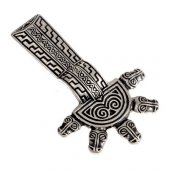 As the disc brooch, the bow brooch was as well an important part of the Germanic four-fibula garb in the early Middle Ages between the 5th and 7th centuries, as already described, and was worn in combination with two disc brooches in the lap area of the dress.
As the disc brooch, the bow brooch was as well an important part of the Germanic four-fibula garb in the early Middle Ages between the 5th and 7th centuries, as already described, and was worn in combination with two disc brooches in the lap area of the dress.Depending on the settlement area, one must distinguish between East Germanic, South Germanic and North Germanic bow brooches, each of which had its characteristics.
In the 5th century, the so-called three-button brooch appeared in the course of the migration period, but was not very widespread, whereas the five-button brooch, coming from Russia, spread from France and Italy to England and was only not common in Scandinavia.
From the five-button brooch, the multi-button brooch finally developed, a brooch with seven or more end buttons.
Another medieval fibula was the so-called bird button fibula, in which the end buttons had the shape of bird heads looking to the side.
In fishing and in Scandinavia, however, instead of bow brooches with end buttons, broad-headed brooches were common, with a rectangular head plate at the end of the bow, which was decorated with elaborate notched patterns.
 The medieval vestment clasps
The medieval vestment clasps
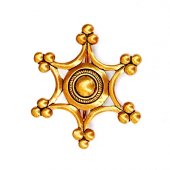 Brooches were used towards the end of the Merovingian period, when the early medieval custom of the four-fibula garb came to an end, which finally also led the bow brooch dying out and this brooch being replaced by other garment clasps.
Brooches were used towards the end of the Merovingian period, when the early medieval custom of the four-fibula garb came to an end, which finally also led the bow brooch dying out and this brooch being replaced by other garment clasps.Instead of the massive fibulae of the early Middle Ages, the vestment clasps in the 11th and 12th century were only made of thin discs and decorated with simple filigree ornaments or engraved patterns, sometimes with inlays of precious stones.
The vestment clasps of the high Middle Ages represent a transition to our present-day brooches, which mainly serve an ornamental purpose and have less the function of closing the actual garment.
Such brooches were usually made of bronze or brass and were used in the 13th and 14th century to close the neckline of the medieval tunic.
This medieval vestment clasp in the form of a completely closed ring was often decorated with Christian texts or liturgical symbolism on the edge.
Besides circular forms, there were also four-fitted clasps with hexagonal or multiple arches, as well as brooches with attached flowers. In addition, there were interlaced clasps in the form of diamonds.
We would be happy if you enjoyed this little excursion about medieval garment clasps and you might find a historical brooch for your authentic outfit in medieval re-enactment.


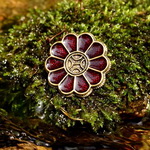 In this section of our medieval shop you will find different types of historical clasp such as reproductions of Celtic brooches and replicas of Roman fibulae and a wide offer of authentic Viking brooches and medieval garment clasps.
In this section of our medieval shop you will find different types of historical clasp such as reproductions of Celtic brooches and replicas of Roman fibulae and a wide offer of authentic Viking brooches and medieval garment clasps.



























